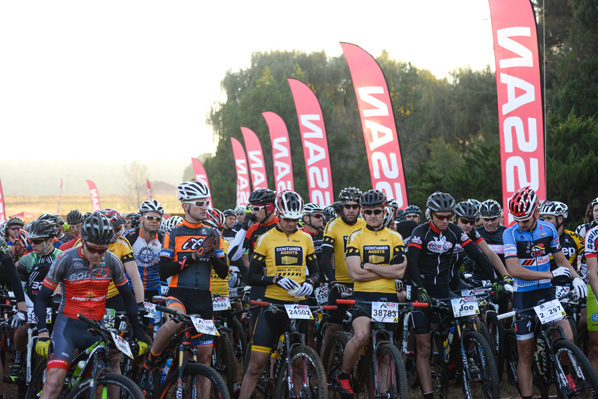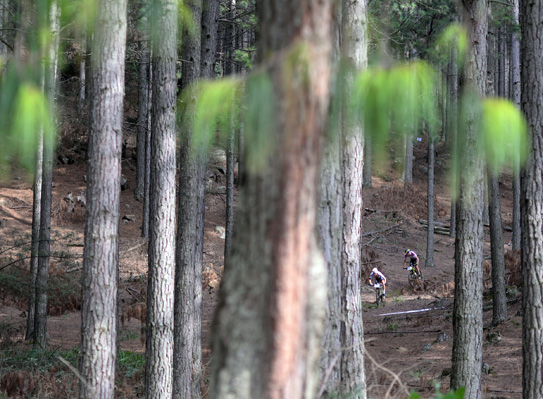So you’ve been riding for a while, you’ve got to know your bike; you’ve got to the point where you’re excited about your next ride. Now what? How about trying a race?
Race is a strong word. Think of it as an organised challenge where you get a time and a position. The good thing about a race is that there are a whole lot of you with a similar goal – to finish the event and enjoy it in the process. You should also get a well-marked/marshalled route, refreshment stations and medical support (if necessary).

A race environment can be intimidating because of the intensity and energy. And then there’s the crowd. Most of your rides have probably been alone or with one or two friends. You may have encountered other mountain bikers on your rides, but never as many as you’ll encounter at a race.
Choosing a race
For your first race, pick a distance that’s within your fitness capabilities and terrain that’s within your skill level. Most races have a website which contains detailed race information. And if you’re still uncertain, call the organiser who will usually give you even more specific route information.
Remember, this is mountain biking, not cricket. Mountain biking isn’t predictable and it isn’t necessarily easy. A race is the same. Part of the appeal of a mountain bike race is that it challenges and sometimes surprises you. Add in the fellow-competitor factor and you have some increased pressure. Go for races that range from 15km-40km. Know that a 40km race can take up to 4 hours if the course is tough and you’re not conditioned to manage it well. If you have any doubts, make your first effort un-ambitious, and live to tell the tale, then move on to the more challenging one the next time. Aim too high, and you might frighten yourself off the next one.
Note: The calendar of events here http://www.buffalomtb.co.za/events/ has a comprehensive list of South African races.

Nutrition
The one thing you want to make sure you don’t run out of during your race, is energy. It’s fuel for your body – it makes your muscles respond to the demands you place on them and helps you think clearly and focus on the trail ahead. That’s a very simple explanation. And a very simple solution is to mix a good quality powdered carb drink to your hydration pack or bottles. They’re designed to give you fast-acting carbohydrate energy and electrolytes to help combat cramping and dehydration. Also take along a couple of sachets or tube of sports energy gel for a quick boost should you need it. And don’t feel shy about stopping at the water points – they often have fruit and snacks too.
Bike
Punctures are like mosquitoes – nobody likes them, they violate you without warning and it’s impossible to completely eliminate them. But with tubeless tyres filled with some form of gooey sealant, you can dramatically reduce your chances of puncturing. Speak to your local bike shop about converting – you’ll never regret it. Never. If your wheels are not tubeless-ready, slime-filled tubes are also available, and work almost as well.
Tighten all bolts (preferably with a torque wrench) to ensure nothing rattles loose during the race. Or ask your local bike shop to service the bike and check everything is working as it should and get them to tighten all bolts. Gears and brakes should work properly, obviously, because you use these more than you’ll know during a race.

Tactics
Be realistic and self-seed yourself in your allocated batch. Starting at the back of the field isn’t a bad idea. That way you have no pressure from riders behind you and you get to pick your way past slower riders, which gives you a mental boost. Start off at a steady pace, one that allows you to talk quite comfortably to your riding buddy. Speaking of which, it’s a good idea to ride your first few races with another mountain biker. Preferably someone with a bit of experience that can guide you or help you repair a puncture (spit) if necessary. By starting at a steady/comfortable pace, you’ll be able to conserve your energy and big efforts for later on or when they’re needed for a tough climb or a rough surface.
Avoid common problems
Chain derailment – usually happens when you shift under pressure to a smaller chainring on a climb. Anticipate and shift before you hit the meat of the climb.
Becoming an obstacle – if you have to stop or dismount, move off the trail as quickly as possible to allow those behind you clear passage.
Becoming a hindrance – on singletrack, if you’ve been caught by a faster rider that needs to pass, look for a widening of the trail and move over for a moment. They usually shout ‘TRACK!’ when they’re approaching from behind. Don’t panic, don’t say ‘pardon’, just move over where possible and let them pass.
Forgetting to drink – a common problem, especially if the terrain is challenging. Try and stop every 15 minutes and take few mouthfuls of your carb drink before continuing.

Take stock
The morning of your first race is nerve-wracking. If you were to forget your helmet, or your shoes at home, you would not be the first, nor last to do so. In the panic of getting ready, you will be surprised what lunacy can creep into your head. So, put them in a plastic bag, and tie it to the handlebars the night before the race. Oh, and if you have to remove wheels to transport your bike/s, count how many wheels are in the car before you drive off… Often – more often than ever thought possible – they stay propped up against your bumper, where you left them as you rushed to load your bike.
Jargon
Chute: barrier-taped area at the start and finish to guide you on your way out and one your way back.
Track!: What faster riders approaching from behind will generally shout to warn you of their imminent arrival.
Bomb: The cylindrical metal tubes that contain compressed CO2 gas that inflate your tyres fast in the case of a puncture.
Goody bag: a bag/packet you often get when you register for your race – sometimes contains something useful. Don’t judge a race by its goody bag.
Number: Seems obvious, but your number identifies you for the sake of safety and your finishing position/time. Make sure it’s secured properly so that it doesn’t rattle loose during the race.



